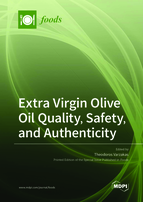Extra Virgin Olive Oil Quality, Safety, and Authenticity
A special issue of Foods (ISSN 2304-8158). This special issue belongs to the section "Food Quality and Safety".
Deadline for manuscript submissions: closed (30 September 2020) | Viewed by 35618
Special Issue Editor
Interests: food technology; food engineering; food safety; food quality; extra virgin olive oil; mycotoxins; fermented foods
Special Issues, Collections and Topics in MDPI journals
Special Issue Information
Dear Colleagues,
The following summary explains the purpose of this Special Issue addressing the very important subject of extra virgin olive oil quality, safety, and authenticity. We hope that you will be able to contribute a research paper or review on the state of the art in this field of research.
Olive oil represents the most consumed edible fat in the food intake of the Mediterranean basin due to the healing effects associated with the so-called “Mediterranean diet”.
Extra virgin olive oil, produced by modern milling technologies, can be directly consumed without any further manipulation.
Protected designation of origin, protected geographical indication, etc. are official European Union classifications, which guarantee the quality and the origin of the labeled foodstuff.
Many factors affect the profiling of the volatile components and the aroma of olive oil, including the cultivar; the atmospheric, pedologic, and fostering conditions; the ripening degree; the olive and oil storing procedure; and the technology of oil extraction from drupes, as has been reported over the last decade.
In extra virgin olive oil production, the quality assessment of raw materials and final products is a fundamental parameter for having and maintaining high quality standards. There are different aspects determining the overall quality of foods: the “quality” (in terms of sensory characteristics, stability, and nutritional value), the “safety” (with respect to microbiology, contaminants, and toxins), and the “authenticity”.
An authentic product, whether raw (olives) or processed (extra virgin olive oil), is one that strictly complies with the declaration given by the producer in terms of ingredients, natural components, absence of extraneous substances, production technology, geographical and botanical origin, production year, and genetic identity. Authenticity is an important issue for the food industry because of issues of legal compliance, economics, guarantees of a constant well-defined quality, safety concerns (no hazardous substitutes), and religious traditions (e.g., Halal or Kosher).
The problem of how to guarantee/ensure food authenticity can be tackled by applying accurate specifications for raw materials and selecting suppliers that have a quality assurance system in place.
Adulteration has always been an unfortunate reality, and it is usually carried out for economical purposes (e.g., to increase the bulk volume, to over-evaluate a product of inferior quality, or to subtract/save expensive ingredients). On the other hand, contaminations may occur accidentally, e.g., in factories, where several oils are produced or used at the same time. These cross-contaminations are usually below 1–2 % of the total amount.
In addition, safety problems can be involved in such adulterations. These cases have been reported with respect to extra virgin olive oil technology and need to be taken into account to minimize the risks involved and raise the issue of food safety and quality, which nowadays should not be jeopardized.
Prof. Dr. Theodoros Varzakas
Guest Editor
Manuscript Submission Information
Manuscripts should be submitted online at www.mdpi.com by registering and logging in to this website. Once you are registered, click here to go to the submission form. Manuscripts can be submitted until the deadline. All submissions that pass pre-check are peer-reviewed. Accepted papers will be published continuously in the journal (as soon as accepted) and will be listed together on the special issue website. Research articles, review articles as well as short communications are invited. For planned papers, a title and short abstract (about 100 words) can be sent to the Editorial Office for announcement on this website.
Submitted manuscripts should not have been published previously, nor be under consideration for publication elsewhere (except conference proceedings papers). All manuscripts are thoroughly refereed through a single-blind peer-review process. A guide for authors and other relevant information for submission of manuscripts is available on the Instructions for Authors page. Foods is an international peer-reviewed open access semimonthly journal published by MDPI.
Please visit the Instructions for Authors page before submitting a manuscript. The Article Processing Charge (APC) for publication in this open access journal is 2900 CHF (Swiss Francs). Submitted papers should be well formatted and use good English. Authors may use MDPI's English editing service prior to publication or during author revisions.
Keywords
- quality
- safety
- extra virgin olive oil
- authenticity







